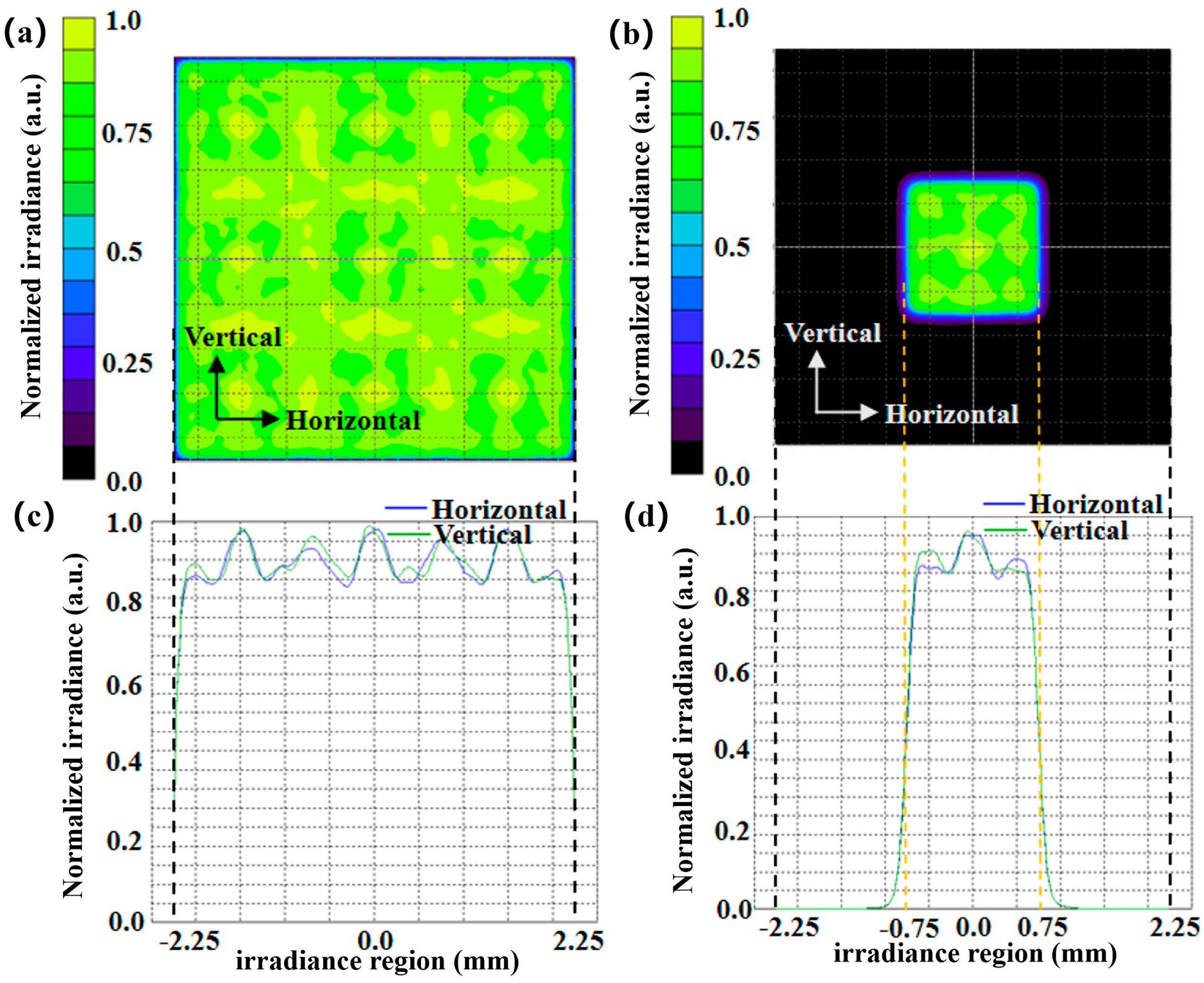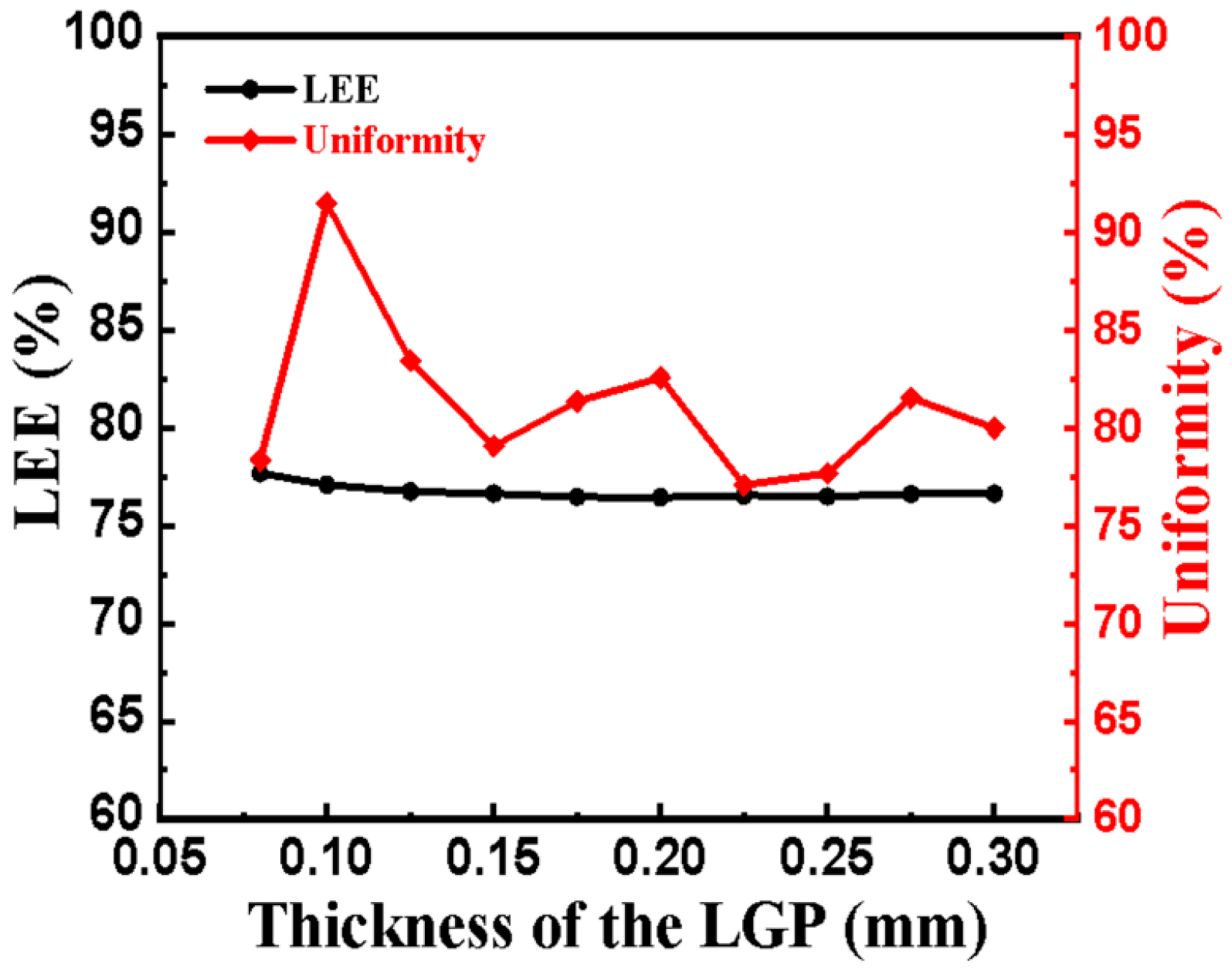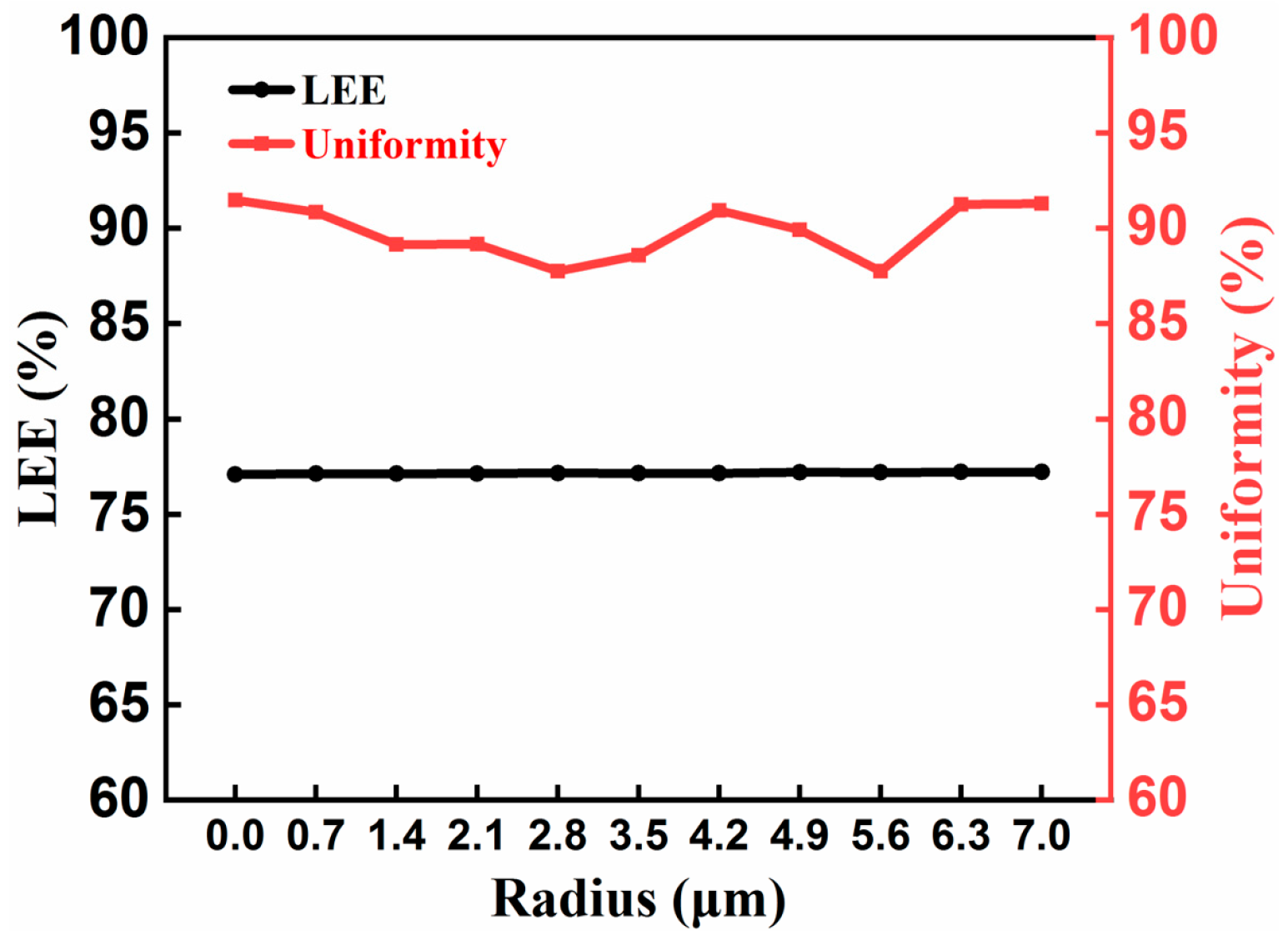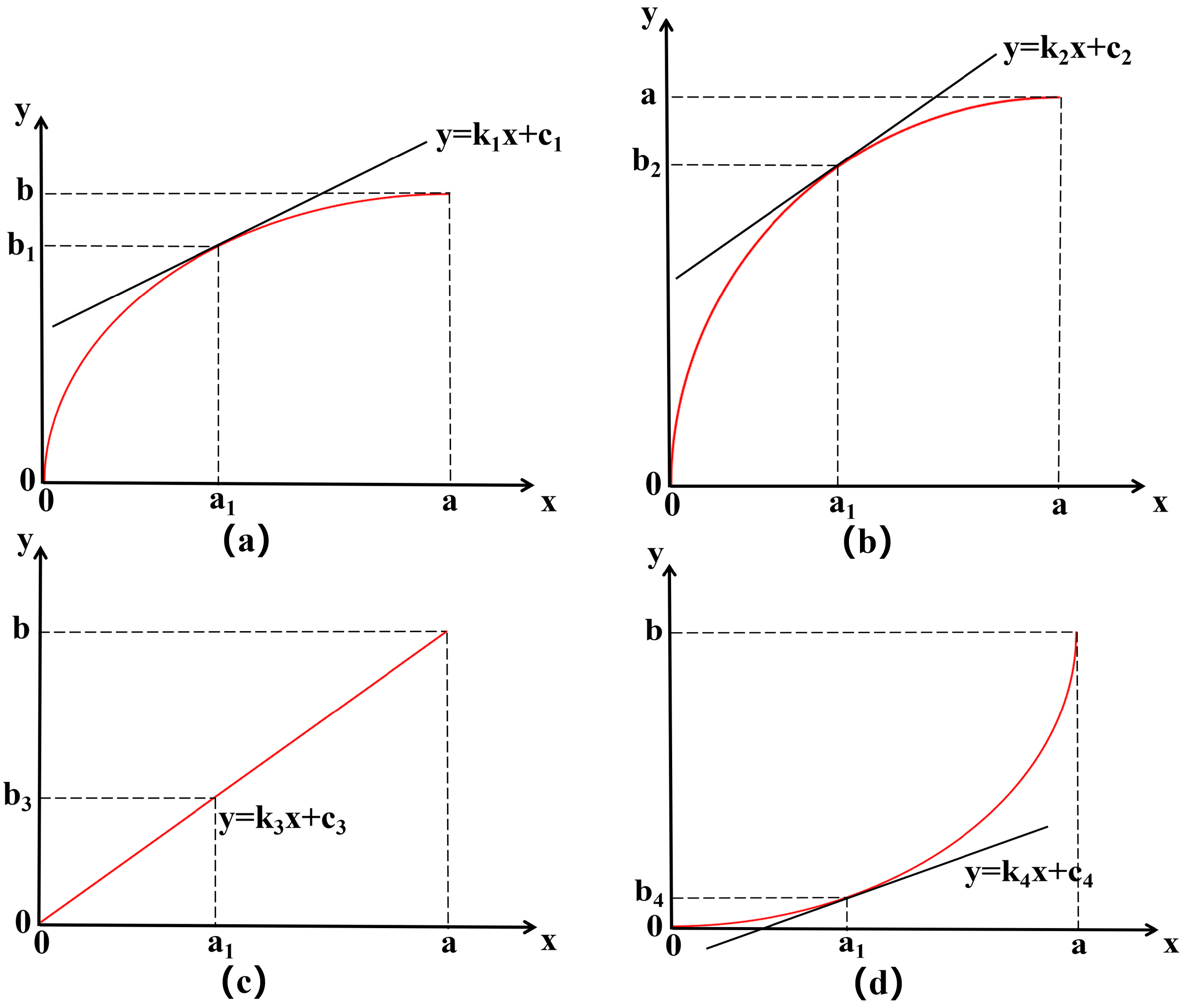Zero-Optical-Distance Mini-LED Backlight with Cone-Shaped Light Coupling Microstructures
Abstract
1. Introduction
2. Design Principle
2.1. Optical Model
2.2. Scattering Dots
3. Simulated Results
3.1. Optical Performance of a Single Local Dimming Zone
3.2. 2D Local Dimming
3.3. White Balance
4. Discussion
4.1. Influence of the LGP’s Thickness on Optical Performance
4.2. Tolerance Analysis
4.3. Comparison between Different Light Coupling Microstructures
5. Conclusions
Author Contributions
Funding
Institutional Review Board Statement
Informed Consent Statement
Data Availability Statement
Conflicts of Interest
References
- Tan, G.; Zhu, R.; Tsai, Y.-S.; Lee, K.-C.; Luo, Z.; Lee, Y.-Z.; Wu, S.-T. High ambient contrast ratio OLED and QLED without a circular polarizer. J. Phys. D Appl. Phys. 2016, 49, 315101. [Google Scholar] [CrossRef]
- Yang, X.; Dev, K.; Wang, J.; Mutlugun, E.; Dang, C.; Zhao, Y.; Tan, S.T.; Sun, X.W.; Demir, H.V. Low-cost, large-scale, ordered ZnO nanopillar arrays for light extraction efficiency enhancement in quantum dot light-emitting diodes. In Proceedings of the 2014 IEEE Photonics Conference, San Diego, CA, USA, 12–16 October 2014; pp. 534–535. [Google Scholar]
- Putman, P.H. Display Technology: The Next Chapter. SMPTE Motion Imaging J. 2016, 125, 30–34. [Google Scholar] [CrossRef]
- Hu, X.; Cai, J.; Liu, Y.; Zhao, M.; Chen, E.; Sun, J.; Yan, Q.; Guo, T.J.O.; Technology, L. Design of inclined omni-directional reflector for sidewall-emission-free micro-scale light-emitting diodes. Optics Laser Technol. 2022, 154, 108335. [Google Scholar] [CrossRef]
- Chen, E.; Zhao, Y.; Lin, S.; Cai, J.; Xu, S.; Ye, Y.; Yan, Q.F.; Guo, T. Design of improved prototype of two-in-one polarization-interlaced stereoscopic projection display. Opt. Express 2019, 27, 4060–4076. [Google Scholar] [CrossRef]
- Cai, J.; Wang, C.; Hu, X.; Ye, Y.; Zhong, L.; Chen, E.; Ye, Y.; Xu, S.; Sun, J.; Yan, Q.; et al. Water-driven photoluminescence reversibility in CsPbBr3/PDMS-PUa composite. Nano Res. 2022, 15, 6466–6476. [Google Scholar] [CrossRef]
- Chen, E.; Lin, J.; Yang, T.; Chen, Y.; Zhang, X.; Ye, Y.; Sun, J.; Yan, Q.; Guo, T. Asymmetric Quantum-Dot Pixelation for Color-Converted White Balance. ACS Photonics 2021, 8, 2158–2165. [Google Scholar] [CrossRef]
- Chen, H.-W.; Lee, J.-H.; Lin, B.-Y.; Chen, S.; Wu, S.-T. Liquid crystal display and organic light-emitting diode display: Present status and future perspectives. Light Sci. Appl. 2018, 7, 17168. [Google Scholar] [CrossRef]
- Burini, N.; Nadernejad, E.; Korhonen, J.; Forchhammer, S.; Wu, X. Modeling Power-Constrained Optimal Backlight Dimming for Color Displays. J. Disp. Technol. 2013, 9, 656–665. [Google Scholar] [CrossRef]
- Chen, E.; Xie, H.; Huang, J.; Miu, H.; Shao, G.; Li, Y.; Guo, T.; Xu, S.; Ye, Y. Flexible/curved backlight module with quantum-dots microstructure array for liquid crystal displays. Opt. Express 2018, 26, 3466–3482. [Google Scholar] [CrossRef]
- Feng, X.; Sun, X.; Zhang, Q.; Yang, Z.; Liu, S.; Qiu, Y.; Wang, D. 21.1: Invited Paper: Development Trend of LCD Technology. Proc. SID Symp. Dig. Tech. Pap. 2018, 49, 207–211. [Google Scholar] [CrossRef]
- Leiner, C.; Nemitz, W.; Schweitzer, S.; Wenzl, F.; Kuna, L.; Reil, F.; Hartmann, P.; Sommer, C. Thin direct-lit application for general lighting realized by freeform micro-optical elements. Proc. Proc. SPIE 2016, 9955, 99550E. [Google Scholar]
- Ding, Z.; Liu, Y.; Ma, Y.; Zheng, Z.; Wang, M.; Zeng, P.; She, J.; Wu, R. Direct Design of Thin and High-Quality Direct-Lit LED Backlight Systems. IEEE Photonics J. 2021, 13, 1–10. [Google Scholar] [CrossRef]
- Huang, C.-H.; Kang, C.-Y.; Chang, S.-H.; Lin, C.-H.; Lin, C.-Y.; Wu, T.; Sher, C.-W.; Lin, C.-C.; Lee, P.-T.; Kuo, H.-C. Ultra-High Light Extraction Efficiency and Ultra-Thin Mini-LED Solution by Freeform Surface Chip Scale Package Array. Crystals 2019, 9, 202. [Google Scholar] [CrossRef]
- Park, Y.-M.; Bang, H.-C.; Seo, Y.-H.; Kim, B.-H. Development of surface-mount-type crown-shaped lens for reducing glare effect of light-emitting diode light source. J. Korean Soc. Manuf. Technol. Eng. 2014, 23, 64–68. [Google Scholar]
- Masuda, J.; Takase, K.; Yamaguchi, N.; Miyata, H. 28-1: Ultra-slim Backlight with High Luminance Using Multiple Advanced Light Guide Plate Technology. SID Symp. Dig. Tech. Pap. 2019, 50, 382–385. [Google Scholar] [CrossRef]
- Yoon, G.-W.; Bae, S.-W.; Lee, Y.-B.; Yoon, J.-B. Edge-lit LCD backlight unit for 2D local dimming. Opt. Express 2018, 26, 20802–20812. [Google Scholar] [CrossRef]
- Chen, E.; Lin, S.; Jiang, Z.; Guo, Q.; Xu, S.; Ye, Y.; Yan, Q.F.; Guo, T. Analytic design of light extraction array for light guide plate based on extended sources. Opt. Express 2019, 27, 34907–34920. [Google Scholar] [CrossRef]
- Jiang, Z.; Ye, Y.; Guo, J.; Pan, J.; Cao, X.; Guo, T.; Chen, E. Optimal dimension of edge-lit light guide plate based on light conduction analysis. Opt. Express 2021, 29, 18705–18719. [Google Scholar] [CrossRef] [PubMed]
- Huang, Y.; Hsiang, E.-L.; Deng, M.-Y.; Wu, S.-T. Mini-LED, Micro-LED and OLED displays: Present status and future perspectives. Light: Sci. Appl. 2020, 9, 105. [Google Scholar] [CrossRef]
- Wu, T.; Sher, C.-W.; Lin, Y.; Lee, C.-F.; Liang, S.; Lu, Y.; Huang Chen, S.-W.; Guo, W.; Kuo, H.-C.; Chen, Z. Mini-LED and Micro-LED: Promising Candidates for the Next Generation Display Technology. Appl. Sci. 2018, 8, 1557. [Google Scholar] [CrossRef]
- Hulze, H.G.; deGreef, P. 50.2: Power savings by local dimming on a LCD panel with side lit backlight. Proc. SID Symp. Dig. Tech. Pap. 2009, 40, 749–752. [Google Scholar] [CrossRef]
- Tan, G.; Huang, Y.; Li, M.-C.; Lee, S.-L.; Wu, S.-T. High dynamic range liquid crystal displays with a mini-LED backlight. Opt. Express 2018, 26, 16572–16584. [Google Scholar] [CrossRef] [PubMed]
- Chen, H.; Tan, G.; Wu, S.-T. Ambient contrast ratio of LCDs and OLED displays. Opt. Express 2017, 25, 33643–33656. [Google Scholar] [CrossRef]
- Ye, Z.T.; Cheng, Y.H.; Liu, K.H.; Yang, K.S. Mini-LEDs with Diffuse Reflection Cavity Arrays and Quantum Dot Film for Thin, Large-Area, High-Luminance Flat Light Source. Nanomaterials 2021, 11, 2395. [Google Scholar] [CrossRef] [PubMed]
- Li, F.; Zong, Z.; Zhang, N.; Mu, L.; Liu, X. 12.3: Research on Reducing H: P Value of Lensless Direct-lit Backlight Module. SID Symp. Dig. Tech. Pap. 2021, 52, 180–182. [Google Scholar] [CrossRef]
- Chang, K.; Yu, L.; Sang, J. P-5.13: Visual Luminance Uniformity and OD value calculation for Direct Type Mini-LED Backlight. SID Symp. Dig. Tech. Pap. 2019, 50, 750–752. [Google Scholar] [CrossRef]
- Chen, Y.-L.; Chin, W.-C.; Tsai, C.-W.; Chiu, C.-C.; Tien, C.-H.; Ye, Z.-T.; Han, P. Wide-Angle Mini-Light-Emitting Diodes without Optical Lens for an Ultrathin Flexible Light Source. Micromachines 2022, 13, 1326. [Google Scholar] [CrossRef]
- Masuda, T.; Watanabe, H.; Kyoukane, Y.; Yasunaga, H.; Miyata, H.; Yashiki, M.; Nara, T.; Ishida, T. 28-3: Mini-LED Backlight for HDR Compatible Mobile Displays. Proc. SID Symp. Dig. Tech. Pap. 2019, 50, 390–393. [Google Scholar] [CrossRef]
- Deng, Z.; Zheng, B.; Zheng, J.; Wu, L.; Yang, W.; Lin, Z.; Shen, P.; Li, J. 74-5: Late-News Paper: High Dynamic Range Incell LCD with Excellent Performance. SID Symp. Dig. Tech. Pap. 2018, 49, 996–998. [Google Scholar] [CrossRef]
- Chen, H.; Ha, T.H.; Sung, J.H.; Kim, H.R.; Han, B.H. Evaluation of LCD local-dimming-backlight system. J. Soc. Inf. Disp. 2010, 18, 57–65. [Google Scholar] [CrossRef]
- Huang, Y.; Tan, G.; Gou, F.; Li, M.-C.; Lee, S.-L.; Wu, S.-T. Prospects and challenges of mini-LED and micro-LED displays. J. Soc. Inf. Disp. 2019, 27, 387–401. [Google Scholar] [CrossRef]
- Gao, Z.; Ning, H.; Yao, R.; Xu, W.; Zou, W.; Guo, C.; Luo, D.; Xu, H.; Xiao, J. Mini-LED Backlight Technology Progress for Liquid Crystal Display. Crystals 2022, 12, 313. [Google Scholar] [CrossRef]
- Chen, E.; Guo, J.; Jiang, Z.; Shen, Q.; Ye, Y.; Xu, S.; Sun, J.; Yan, Q.; Guo, T. Edge/direct-lit hybrid mini-LED backlight with U-grooved light guiding plates for local dimming. Opt. Express 2021, 29, 12179–12194. [Google Scholar] [CrossRef] [PubMed]
- Kikuchi, S.; Shibata, Y.; Ishinabe, T.; Fujikake, H. Thin mini-LED backlight using reflective mirror dots with high luminance uniformity for mobile LCDs. Opt. Express 2021, 29, 26724–26735. [Google Scholar] [CrossRef] [PubMed]
- Teng, T.-C.; Kuo, M.-F. Optical characteristic of the light guide plate with microstructures engraved by laser. Proc. Proc. SPIE 2012, 8485, 201–208. [Google Scholar]
- Chung, C.-K.; Sher, K.-L.; Syu, Y.-J.; Cheng, C.-C. Fabrication of cone-like microstructure using UV LIGA-like for light guide plate application. Microsyst. Technol. 2010, 26, 1619–1624. [Google Scholar] [CrossRef]
- Yi, P.; Wu, H.; Zhang, C.; Peng, L.; Lai, X. Roll-to-roll UV imprinting lithography for micro/nanostructures. J. Vac. Sci. Technol. B Nanotechnol. Microelectron. Mater. Process. Meas. Phenom. 2015, 33, 060801. [Google Scholar] [CrossRef]
- Kim, S.-W.; Kim, H.-G.; Lee, S.-E.; Lee, H.; Lee, H.-C. Fabrication of Film-Type Light Guide Plates by Using UV Nano-Imprint Lithography to Enhance Optical Properties. Nanosci. Nanotechnol. Lett. 2016, 8, 13–20. [Google Scholar] [CrossRef]
- Fan, F.-Y.; Chou, H.-H.; Lin, W.-C.; Huang, C.-F.; Lin, Y.; Shen, Y.-K.; Ruslin, M. Optimized micro-pattern design and fabrication of a light guide plate using micro-injection molding. Polymers 2021, 13, 4244. [Google Scholar] [CrossRef] [PubMed]
- Zeng, X.-Y.; Yang, L.; Zhou, X.-T.; Zhang, Y.-A.; Chen, E.-G.; Guo, T.-L. Pixel arrangement optimization of two-dimensional light-emitting diode panel for low-crosstalk autostereoscopic light-emitting diode displays. Opt. Eng. 2017, 56, 063104. [Google Scholar] [CrossRef]
- Zeng, X.-Y.; Zhou, X.-T.; Guo, T.-L.; Yang, L.; Chen, E.-G.; Zhang, Y.-A. Crosstalk reduction in large-scale autostereoscopic 3D-LED display based on black-stripe occupation ratio. Opt. Commun. 2017, 389, 159–164. [Google Scholar] [CrossRef]
- Xu, S.; Yang, T.; Lin, J.; Shen, Q.; Li, J.; Ye, Y.; Wang, L.; Zhou, X.; Chen, E.; Ye, Y.; et al. Precise theoretical model for quantum-dot color conversion. Opt. Express 2021, 29, 18654–18668. [Google Scholar] [CrossRef] [PubMed]










| Coordinate Position (x, y) | CIE 1931 Color Coordinate (x, y) |
|---|---|
| (0.6, 0.6) | (0.2931, 0.3278) |
| (0.6, 0.0) | (0.3071, 0.3497) |
| (0.6, −0.6) | (0.2886, 0.3188) |
| (0.0, 0.6) | (0.3063, 0.3491) |
| (0.0, 0.0) | (0.3068, 0.3509) |
| (0.0, −0.6) | (0.3085, 0.3546) |
| (−0.6, 0.6) | (0.2925, 0.3249) |
| (−0.6, 0.0) | (0.3088, 0.3535) |
| (−0.6, −0.6) | (0.2968, 0.3382) |
| Type | LEE | Uniformity |
|---|---|---|
| Cone shape | 77.09% | 91.47% |
| Circle shape | 80.62% | 81.61% |
| Inverted triangle shape | 77.23% | 88.07% |
| Concave shape | 69.62% | 85.8% |
Disclaimer/Publisher’s Note: The statements, opinions and data contained in all publications are solely those of the individual author(s) and contributor(s) and not of MDPI and/or the editor(s). MDPI and/or the editor(s) disclaim responsibility for any injury to people or property resulting from any ideas, methods, instructions or products referred to in the content. |
© 2023 by the authors. Licensee MDPI, Basel, Switzerland. This article is an open access article distributed under the terms and conditions of the Creative Commons Attribution (CC BY) license (https://creativecommons.org/licenses/by/4.0/).
Share and Cite
Lin, Z.; Jiang, H.; Ye, D.; Zhang, W.; Chen, E.; Ye, Y.; Xu, S.; Yan, Q.; Guo, T. Zero-Optical-Distance Mini-LED Backlight with Cone-Shaped Light Coupling Microstructures. Crystals 2023, 13, 241. https://doi.org/10.3390/cryst13020241
Lin Z, Jiang H, Ye D, Zhang W, Chen E, Ye Y, Xu S, Yan Q, Guo T. Zero-Optical-Distance Mini-LED Backlight with Cone-Shaped Light Coupling Microstructures. Crystals. 2023; 13(2):241. https://doi.org/10.3390/cryst13020241
Chicago/Turabian StyleLin, Zibin, Haonan Jiang, Daochun Ye, Wenyan Zhang, Enguo Chen, Yun Ye, Sheng Xu, Qun Yan, and Tailiang Guo. 2023. "Zero-Optical-Distance Mini-LED Backlight with Cone-Shaped Light Coupling Microstructures" Crystals 13, no. 2: 241. https://doi.org/10.3390/cryst13020241
APA StyleLin, Z., Jiang, H., Ye, D., Zhang, W., Chen, E., Ye, Y., Xu, S., Yan, Q., & Guo, T. (2023). Zero-Optical-Distance Mini-LED Backlight with Cone-Shaped Light Coupling Microstructures. Crystals, 13(2), 241. https://doi.org/10.3390/cryst13020241







